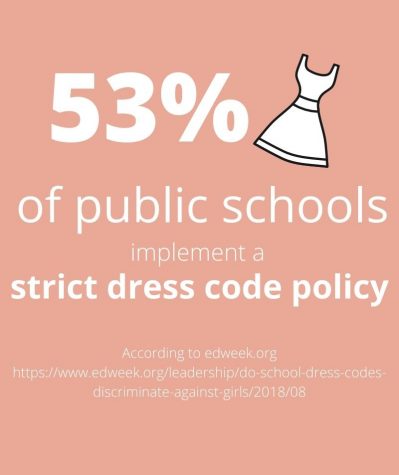“Too much skin.”
When students hear that phrase, it is because they have violated the school dress code. Despite its everyday presence at school, many don’t know why dress codes exist or what they accomplish.
In reality, school dress codes have been around for a long time. In 1969, the controversy started with the U.S. Supreme Court case Tinker v. Des Moines Independent School District. Students had worn black armbands to protest the Vietnam War.
According to Findlaw, a company that provides legal information, “The [Supreme] Court essentially decided that schools may limit student expression (such as enforcing dress codes) if there is a legitimate concern that such expression will be disruptive to the learning environment or violate the rights of others.”
If anyone was wearing something that could be viewed as a distraction, it could violate the school dress code.
For hundreds of years, women and men have not been seen on the same level, professionally and privately.
Back in the late 1800s, people treated women with disregard. Society expected men to be the ones to work while women had to stay at home to cook, clean, bear, and take care of children. Men could do as they pleased and wouldn’t have any consequences, while women had to face much discrimination.
According to Olivia Campbell, writer of “The Historical Struggles to Rid Socialism of Sexism,” “Husbands could beat and rape their wives with little worry of recourse; in 1910, the U.S. Supreme Court denied wives the right to prosecute their husbands for assault.”
Men held power over women in the household and the general public, so when schools started to implement such things as dress codes, they showed some biases.
“The dress code has affected me because, as a girl, we have always been told to cover up because boys can’t ‘help themselves.’ I would get told to go and change because it was ‘too distracting.’ It has affected how I thought the school should be; of course, you shouldn’t wear anything too revealing, but my shoulders, legs, or back should not be distracting,” said Michelle Meskin, a sophomore.
To Meskin, the way people dress is not distracting. Instead, it is the way some individuals perceive their clothes.
Nowadays, dress codes appear at most schools in various forms such as uniforms or a set list of rules. Some common rules are for bottoms to be at least fingertip length, a covered stomach area, and shirt straps to be the width of at least two fingers.
According to the dress code in the Carlmont High School planner, “Administration reserves the right to determine if clothing is too revealing or intentionally inappropriate for the school environment.”
Many girls get pulled out of class due to dress code violations, which impact their learning time.
“The school system has to change. It is unfair to pull me out of class, tell me to change, all for boys’ learning,” Meskin said.
Meskin claims that the dress code has impacted her learning by reducing her learning time. However, schools claim dress codes are maintained to ensure the students are ready for their future and are perceived as responsible young adults.

“The dress code policy is designed to support them in meeting this expectation. We believe that our dress code policy is in alignment with our mission to guide students towards becoming good citizens and participants in the employment market and the larger society; school is a student’s place of business,” said Greg Patner, an administrative vice principal at Carlmont. “Part of this responsibility involves appropriate dress and personal appearance.”
Based on a study conducted by professors Jimmy Creel and Angela Stallings, dress codes had no impact on state tests. However, the presence of a dress code showed benefits towards school spirit, teamwork, and image.
“There is an intentionality to writing the dress code up to be universal,” Patner said. “Fashions and trends change over time, however, and sometimes one gender might be more out of compliance with the dress code than another based on fashion decisions. Not long ago, sagging pants, largely worn by male students, was in conflict with dress codes throughout the district, and there were several violations in response to this fashion style.”
On the one hand, administrators feel it should be mandatory for there to be order at school and a focus on learning. On the other hand, students think they should have the freedom to express themselves through their clothes, and they are mature enough to make their own decisions.
“I don’t think the dress code is helpful or important because, at our age, we are mature enough to know how to appropriately dress for school,” said Anna Bautina, a sophomore.













